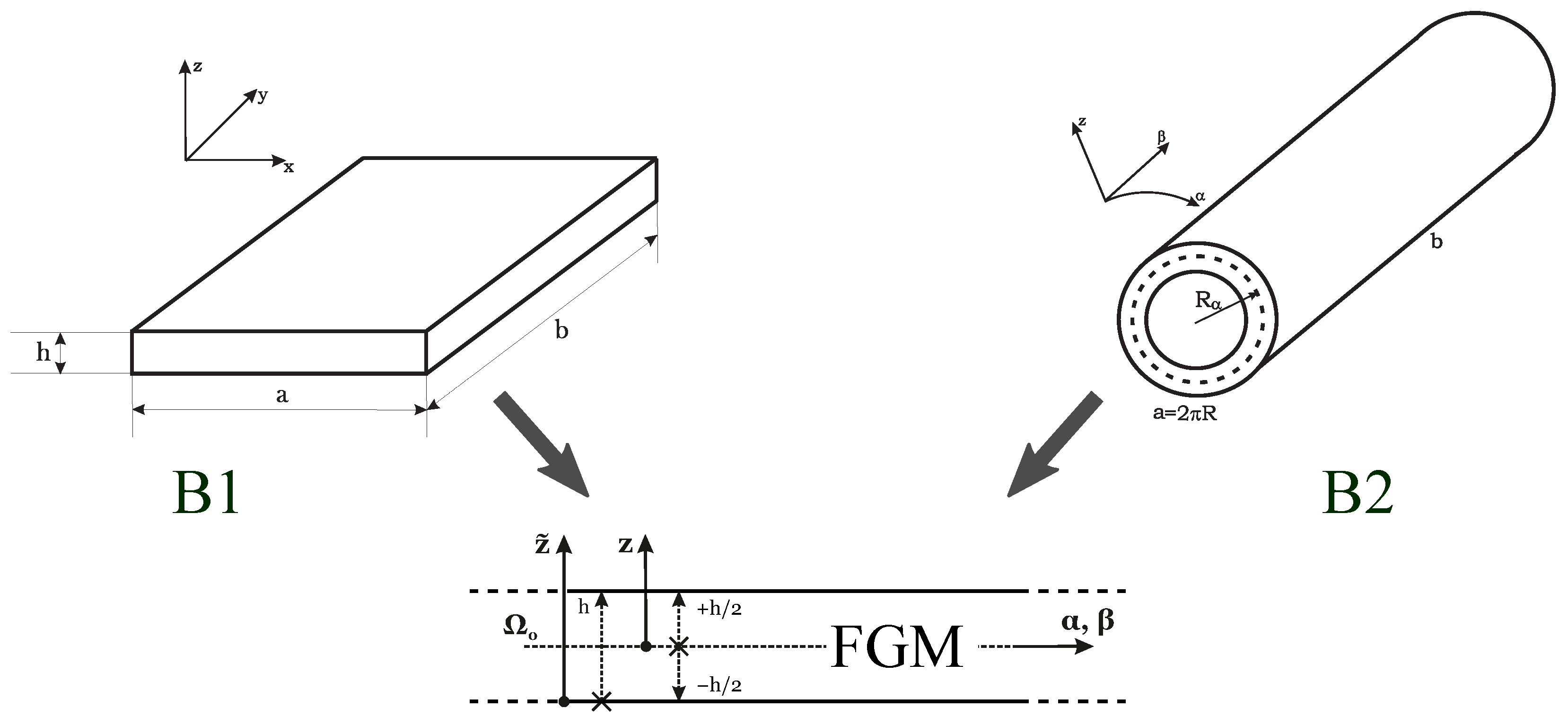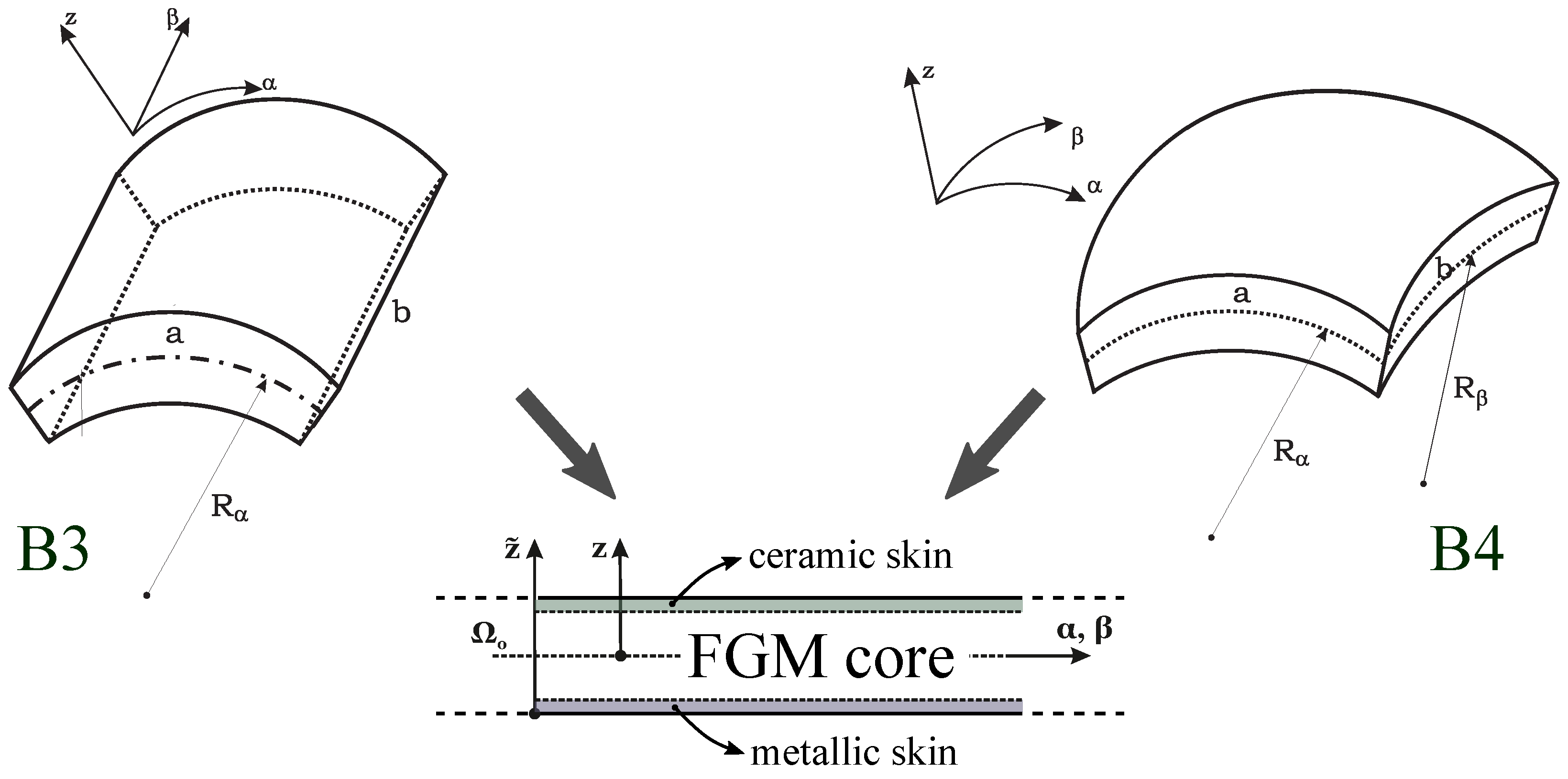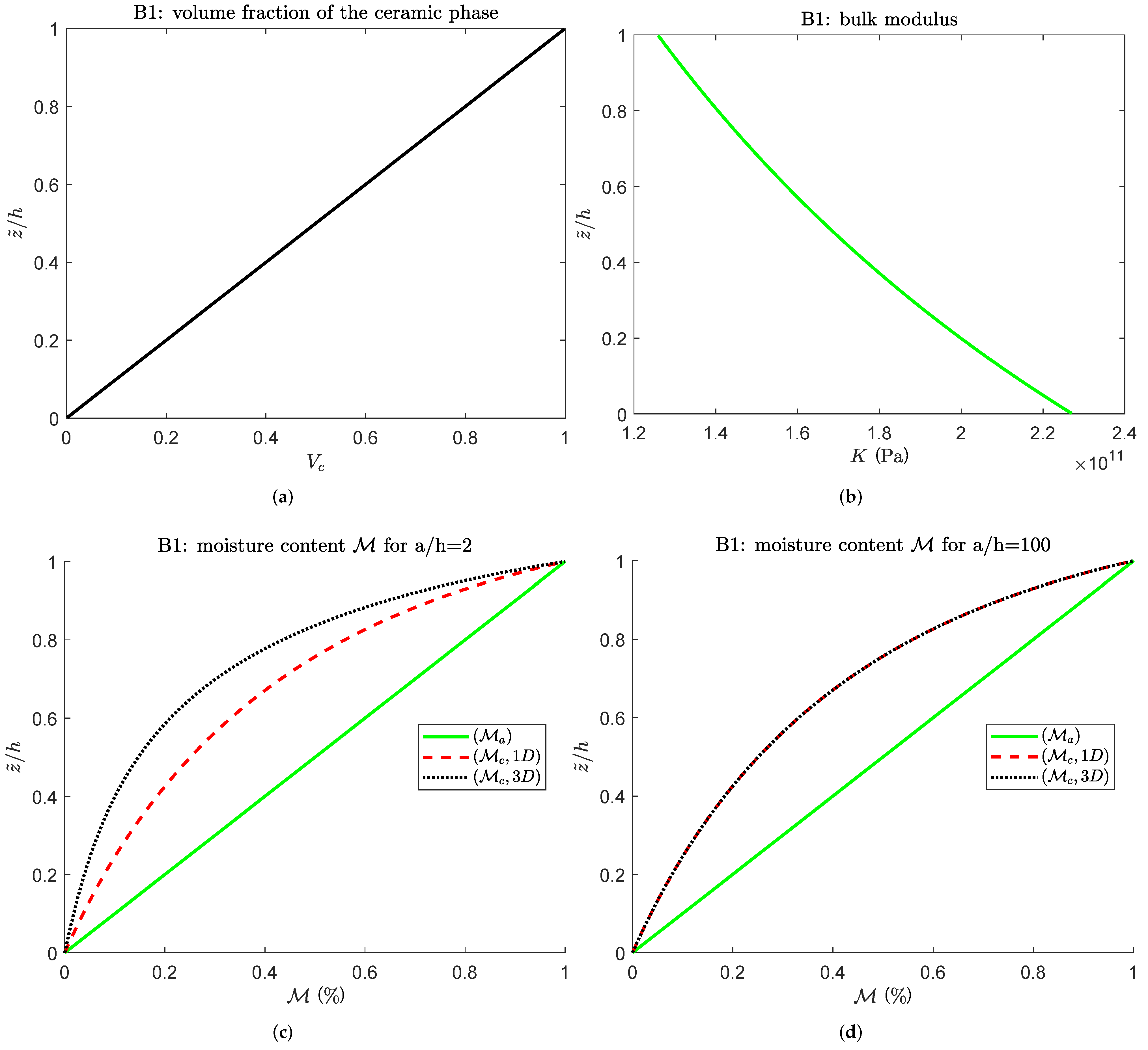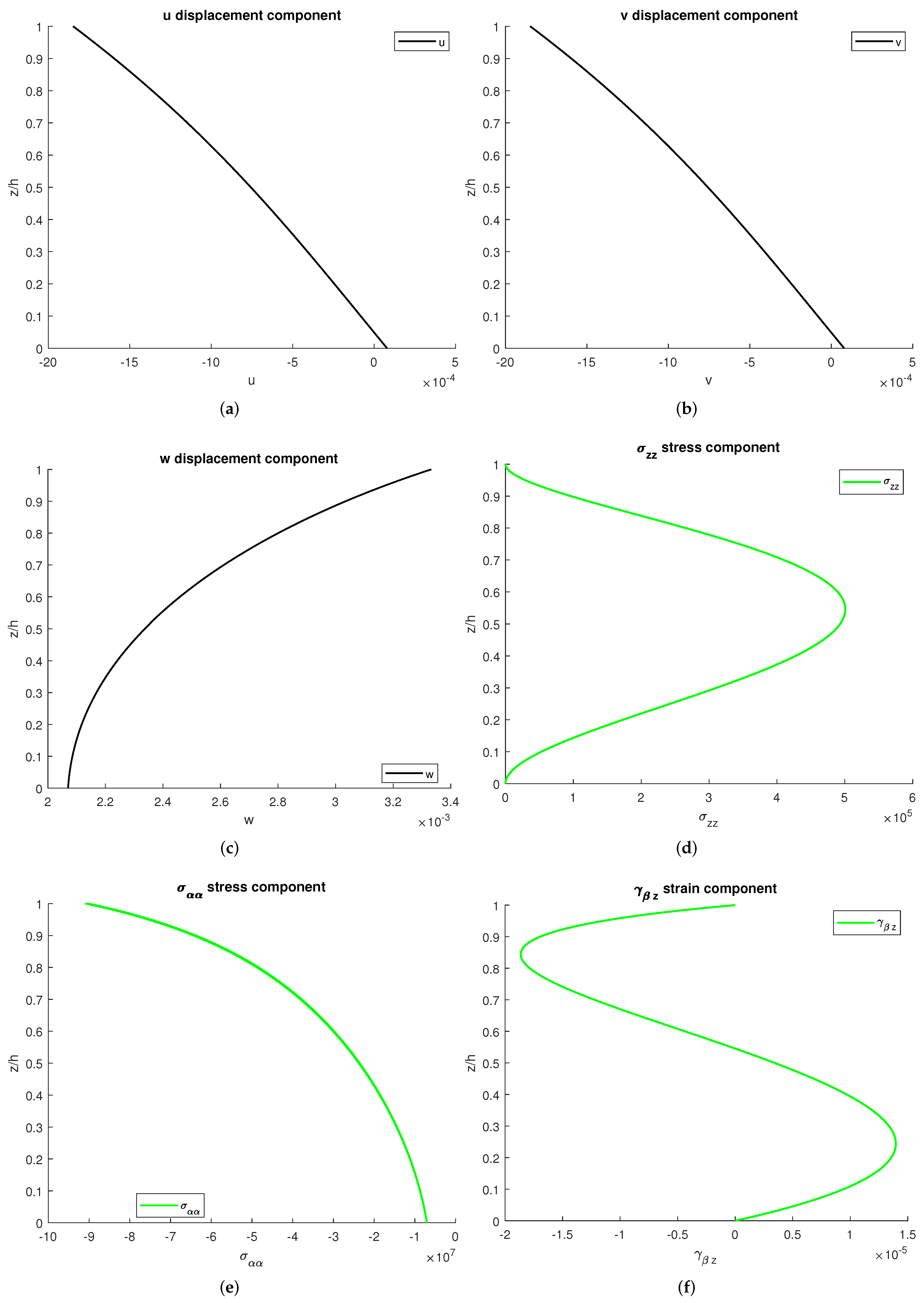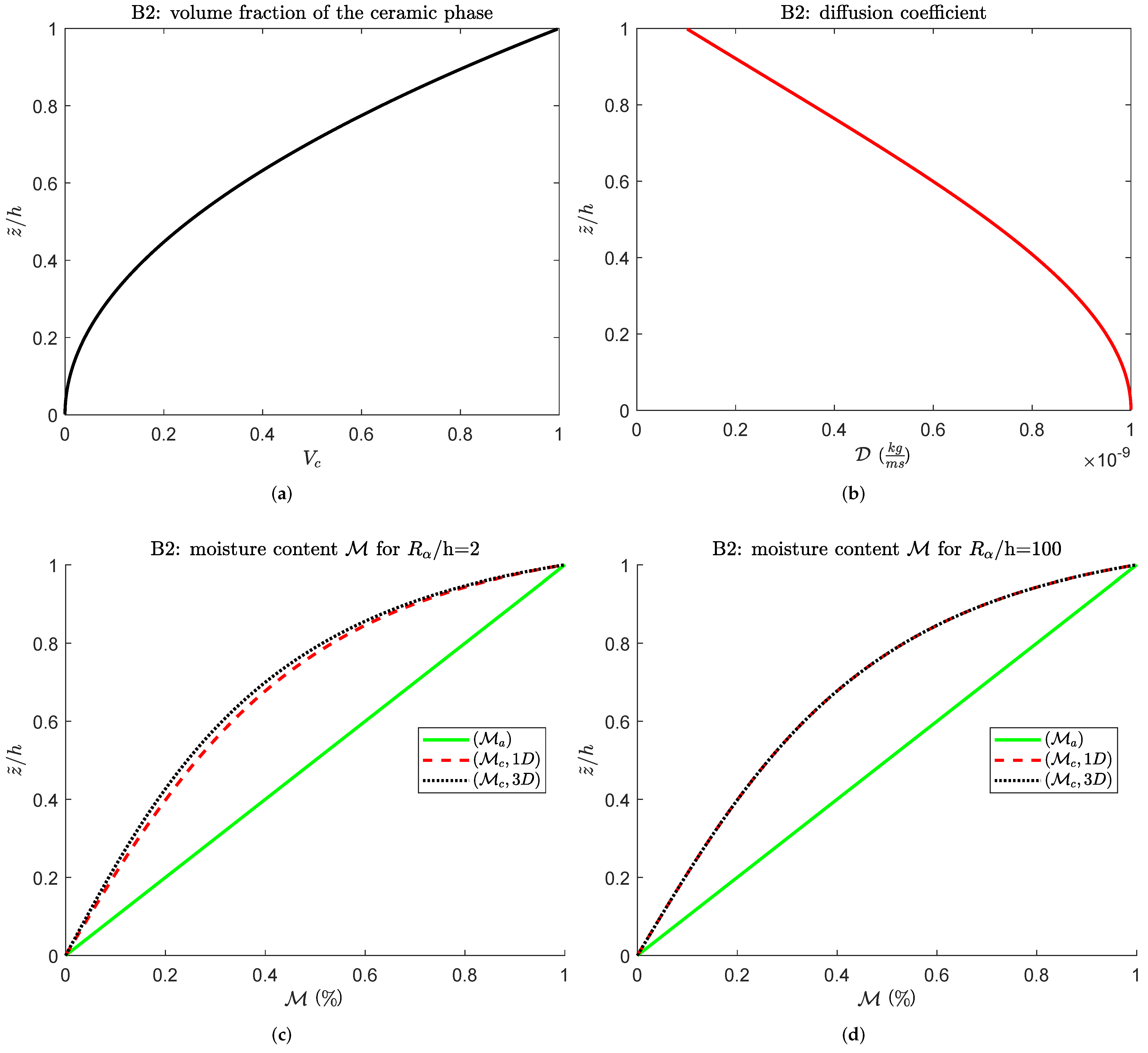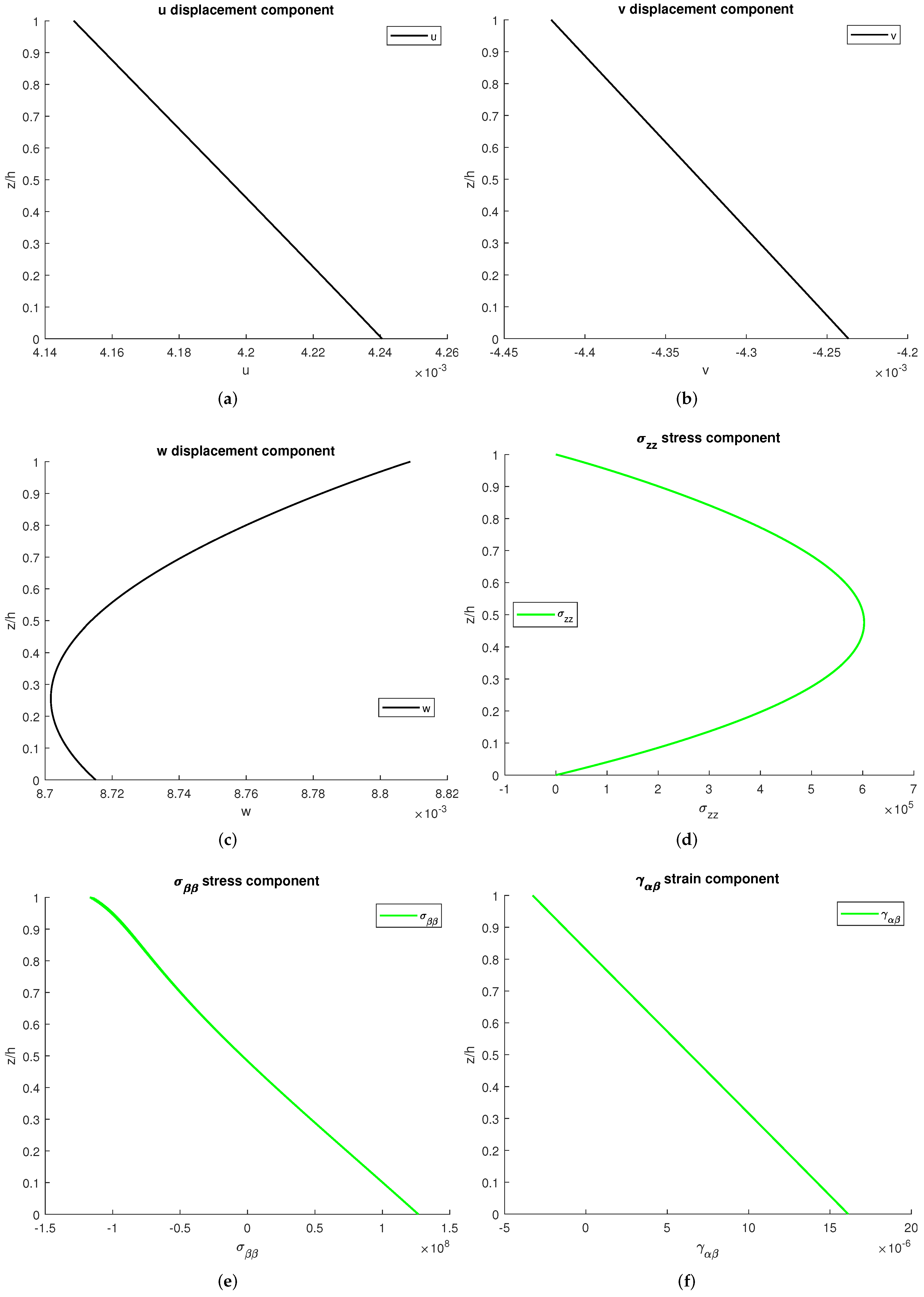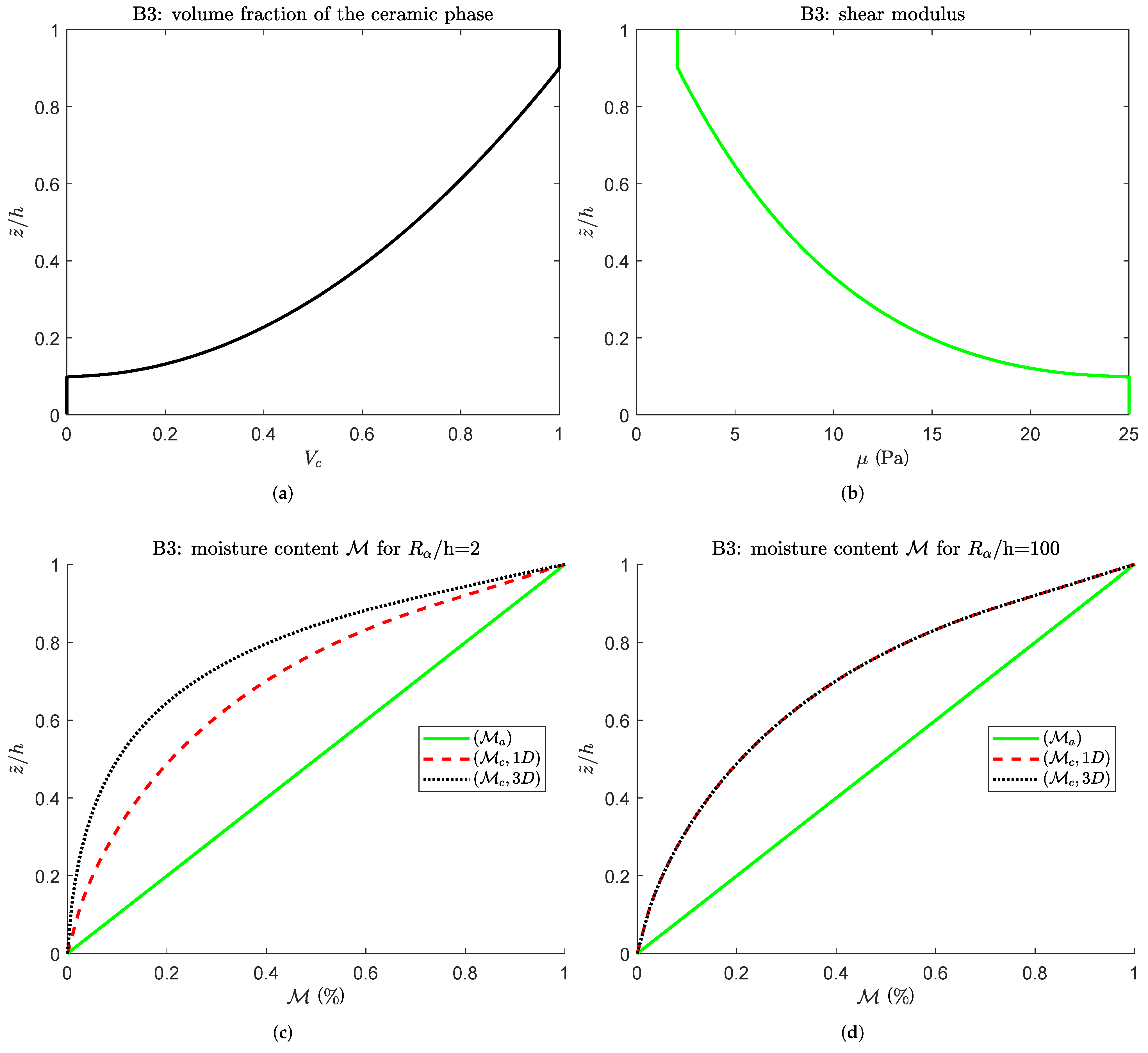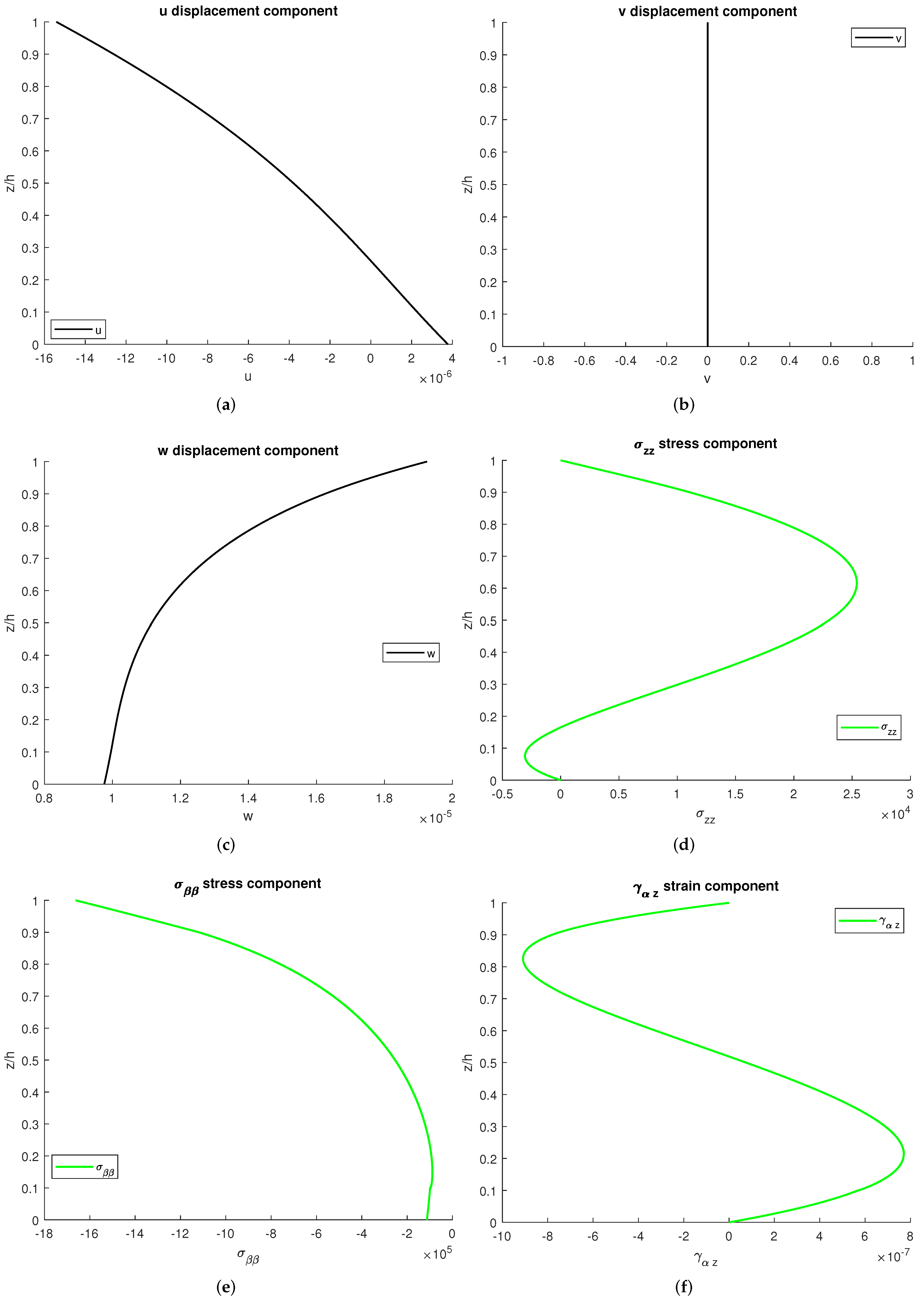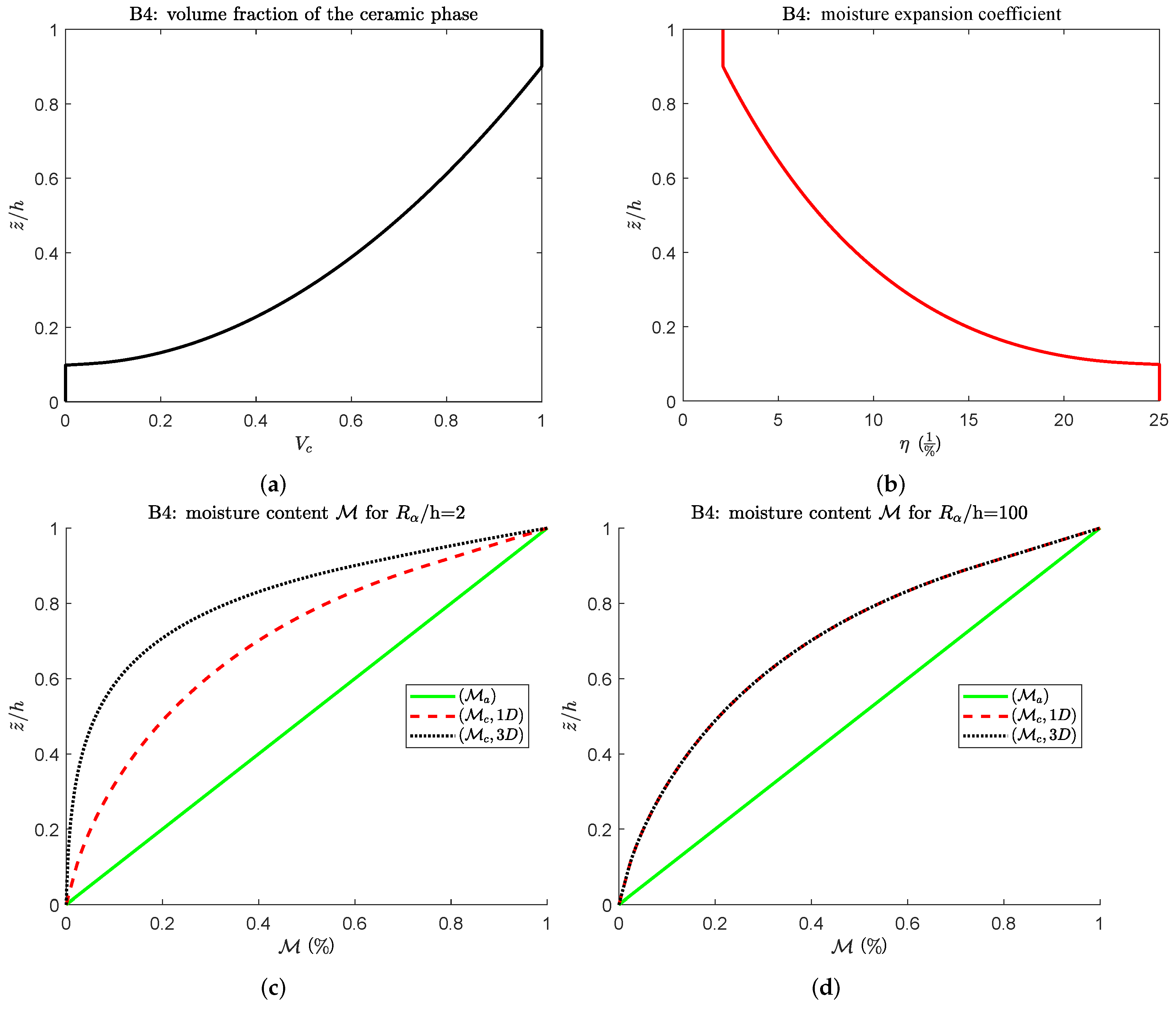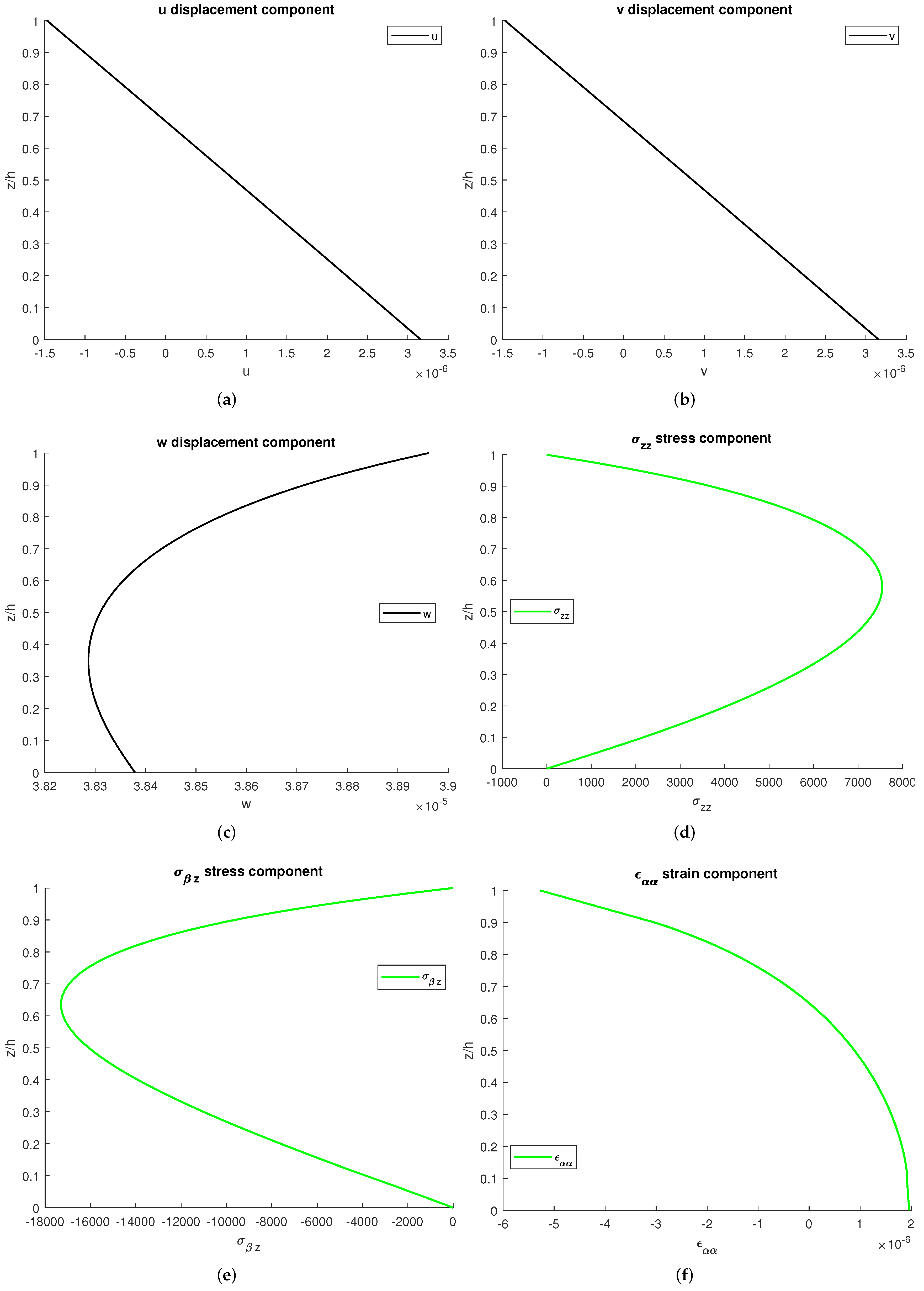1. Introduction
The environmental conditions characterizing the service life of structural components can be adverse in many applications. The aerospace field gives several examples of changing environments, which results in temperature gradients and moisture concentration variability. It is crucial to consider such two factors and to include them in a proper structural analysis: the thermal and hygrometric fields induce an internal stress distribution, which changes as soon as the environmental conditions change. As with any stress field, it might induce failures on the structure [
1], either on its own or because it sums up to that caused by classical mechanical loads. Composite, multilayered, and FGM-embedding structures require a special focus. Composite materials can also be degraded by moisture absorption and the following diffusion through the matrix [
2]; multilayered structures highlight a strong heterogeneity in the hygro/thermal/mechanical properties; FGMs induce a further complication due to non-constant terms in governing equations. However, their boosted implementation in critical structural applications recently increased the attention of the researchers on these effects.
Laminated structures and composite materials suffer from a clear variation of the properties at the interfaces, which is the critical source of the delamination process [
3]. Eliminating this discontinuity and substituting it with a smooth trend is the key achievement of Functionally Graded Materials (FGMs). They are advanced composite materials made by two or more different phases mixed with a continuous graded distribution. As a result, they are heterogeneous materials, delivering optimized responses for each application: the advancements in processing technologies made it possible to control a unidirectional and even multidirectional variation. Combinations of a metallic and a ceramic phase are classic examples of FGMs finding application in severe thermal environments: they overcome the differences in thermal properties of the two constituents and, at the same time, deliver a reduced thermal stress distribution. Stiffness coefficients, hardness, thermal conductivity, moisture diffusivity, and corrosion resistance are just some examples of the performance characteristics that can be combined and enhanced [
4].
Several recent and relevant works focused on structures embedding FG layers underline their importance in practical applications. From an analytical perspective, Sobhani et al. recently proposed several analytical results in the frame of the vibration analysis of FG shells. First, the governing equations followed the First-order Shear Deformation Theory (FSDT); then, they used the Generalized Differential Quadrature Method (GDQM), a semi-analytical solution method, to solve the system of partial differential equations. They studied conical shells embedding hybrid matrix/fiber nanocomposites in [
5]; the approach was then extended to paraboloidal and hyperboloidal shells embedding polymer matrix, carbon fiber, and graphene nanoplatelets in [
6]. Using the same approach, they studied sandwich conical-cylindrical-conical shells [
7]. The layers are reinforced with functionally graded carbon nanotubes and graphene nanoplatelets; they described the elastic coefficients following an Equivalent Single Layer approach. They also studied five different patterns of CNT fibers distribution inside of the matrix while defining the vibrational behavior of coupled conical-conical shells [
8]. They used the five-parameter shell theory and solved the differential equations through GDQM. Three-phase nanocomposites were also studied in hemispherical-cylindrical shells exploiting a similar approach [
9] and defining the governing equations through the first-order shear deformation theory. From a numerical perspective, Rezaiee-Pajand et al. studied sandwich beams embedding FGM in two ways: they applied the Ritz method and the principle of minimum total potential energy within the framework of Timoshenko and Reddy beam theories in [
10] to assess the bending of beams with different cross sections; they also developed a four-node isoparametric beam element to study porous beams with FGM [
11]. Concerning two-dimensional geometries, the same authors proposed the nonlinear analysis of FG shells in [
12,
13] by improving an isoparametric six-node TRIA element with strain interpolation functions; the mechanical properties grading followed a power low. They also proposed a three-node TRIA element [
14] using a mixed strain finite element approach and demonstrated that it is possible to get the exact response of the beams with a low number of elements under large deformations.
The solutions available in the literature seem to be promising. However, the results of a hygrometric stress analysis depend not only on the capabilities of the elastic model implemented but also on how the moisture content field has been evaluated, given the external boundary conditions. The hygrometric field acts as a field load; its quantification necessarily influences the stress analysis results. Aerospace applications usually involve thin components. Consequently, evaluating the moisture content field translates into determining its profile along with the thickness direction, generally coinciding with the grading direction of the mechanical/hygrometric properties. Developing a mechanical/elastic model for a thin component can be done at different levels of detail: 3D or 2D approaches, coupled with an analytical or numerical method. However, this might not be sufficient in defining the refinement of a model when hygrometric stresses are concerned. Even an analytical, exact 3D model would give wrong results when fed from an inaccurate moisture content field. The molecular diffusion depends on the gradient of the concentration and is described by Fick’s law. A solid mathematical analogy between Fick’s law and the Fourier heat conduction equation strongly simplifies the analysis and the dissertation. An exact solution comes from resolving three-dimensionally the diffusion/conduction equations; however, simplified solutions might benefit from their unidirectional simplification or an assumed-linear profile. Those three situations require an external evaluation of the moisture content field before the mechanical analysis. An alternative consists in defining a coupled hygro-mechanical model, in which the moisture content field is a primary variable of the problem in analogy with the thermal field [
15,
16,
17,
18,
19,
20].
This paper discusses an hygro-elastic shell model, which relies on the exponential matrix method. This model does not limit to a specific geometry or lamination scheme; on the contrary, it handles plates, cylindrical, and spherical shells. Furthermore, it accepts one or more FGM layers on their own or coupled with homogeneous layers (sandwiches give an example). It extends the authors’ 3D exact thermo-elastic shell model discussed in [
21] to hygro-elastic stress analysis. The problem is defined under steady-state conditions only; the solution requires the moisture content amplitudes at the top and bottom external surfaces to be specified. As a first step, the solution evaluates the moisture content profile through the thickness direction. The authors considered three possible options: the 3D Fick diffusion law, its 1D simplified version, and an a priori assumed linear trend. Despite this, the model handles the solution via a layer-wise approach and through the exponential matrix method. The present authors are not the only ones using the exponential matrix method for solving the differential equilibrium equations. Soldatos and Ye [
22] already used it in analyzing the free vibrations of cylinders; Messina [
23] applied it to study multilayered plates. The orthogonal mixed curvilinear coordinate system helped study spherical shells in [
24] using three transverse stress and three displacement components as primary variables of the problem. The analytical procedure is in analogy with the free vibration analysis and the static analysis under mechanical load discussed by the first author in [
25,
26,
27,
28,
29,
30]. Those previous formulations already handled different materials and geometries but lacked loads other than the mechanical ones. In those simpler cases, a set of three homogeneous differential equations are at the basis of the problem. However, the hygrometric load adds an additional term that makes them not homogeneous. The exponential matrix method also handles this feature, as discussed in [
21] for the thermoelastic stress analysis of shells with FGMs. The closed-form solution of the problem is possible given the harmonic forms imposed on the variables (displacements and hygrometric field) and the simply supported boundary conditions. Moreover, the whole formulation benefits an orthogonal mixed curvilinear coordinate system, following the suggestions in [
31,
32,
33,
34]. This strategy introduces a set of curvature terms, the elements through which the equations automatically adapt to the different geometries. Such terms are a function of the thickness coordinate, together with the elastic and hygrometric coefficients in FGM layers. Introducing a set of fictitious (mathematical) layers allows obtaining constant coefficients and using the method discussed in [
35] to solve the problem.
The literature overview offers different analytical and numerical 2D models handling the hygrometric stress analysis; they specifically focus on multilayered structures. Far fewer discuss the problem of structures embedding FGMs. The literature overview will demonstrate that, to the authors’ knowledge, no analytical 3D shell model exists, in which the structures are different, provided that they have constant radii of curvature, and the moisture content evaluation follows three different approaches. Laoufi [
36] studied rectangular plates embedding FGMs when subjected to different boundary conditions, including moisture content and temperature field. They developed an analytical method through the hyperbolic shear deformation plate model, which satisfied the stress boundary conditions and required no shear corrections. The volume fractions of the ceramic-metal constituents were used to define the materials grading in the thickness direction following a power law. The same power law was included in Inala’s work [
37], devoted to studying how the hygrothermal environment affects the vibration characteristics of plates embedding FGMs. To do this, the author developed a finite element model of the structures under investigation. Dai [
38] and his colleagues focused on circular plates with a variable thickness along with the radial direction. They derived nonlinear governing equations for temperature, moisture content, and displacement fields and solved them through the differential quadrature method. Zenkour also studied how the thermal and hygrometric fields affect the bending and the buckling of plates embedding FGMs [
39]. In this case, also, the authors considered a material grading in the thickness direction of the structure. Their formulation relies on an exponential shear deformation theory and applies to plates resting on elastic foundations. Hamilton’s principle was used to derive the equilibrium equations, and Navier’s method to obtain the results. Boukelf also studied plates resting on elastic foundations, embedding FGMs [
40]. The author developed a novel higher-order shear deformation theory model, deducing the problem equations through the virtual work principle. Hygro, thermal, and mechanical loads are all properties that can be handled. Analogously, Zidi [
41] developed a further model for the same issue. In this case, the author used a four-variable refined plate theory. Analogous research has been proposed in [
42] concerning functionally graded beams. The author deepened the influence of moisture content field and temperature on the bost-buckling response of beams. A nonlinear finite element solution was considered, in which the authors handled the kinematics of the bost-buckling through the Lagrangian approach.
More substantial is the literature discussing the moisture content effects on isotropic, orthotropic, and laminated structures. Chiba and Sugano [
43] studied multilayered plates and proposed a two-dimensional analytical solution for hygrothermal effects on multilayered plates. The Classical Lamination Plate Theory and an analytical 3D plate model were compared in [
44,
45] while performing the hygro-thermal stress analysis. The CLT also received the attention of Kalil [
46] when he investigated composite plates. Kollar [
47] made an analytical investigation of composite cylindrical shells, while Shen [
48] focused on buckling and post-buckling behaviors. The CLT was found to be inadequate in hygrothermal mechanical analysis by Lee and his colleagues [
49]. There is no shortage of numerical models in this field; an example is given in [
50], where plates with a central hole were studied. Multilayered structures under hygrometric fields have been the target of the finite element model by Khoshbakht et al. [
51]; Kundu and Han studied buckling and vibration in multilayered shells with double curvature [
52] through a finite element model grasping the hygrothermal effects. They extended this research to dynamic instability of doubly-curved shells embedding composite materials through a nonlinear finite element under orthogonal curvilinear coordinates [
53]. Marques and Creus included the Fick diffusion law [
54] into a FE shell model devoted to isotropic and multilayered structures under a hygrothermal environment. With the same aim, Naidu and Sinha [
55] investigated cylindrical shell panels under large deflections through a higher-order shear deformation theory. Patel also proposed a higher-order FE for laminated parts [
56]. Sereir et al. [
57,
58,
59] considered the elastic properties variation in composite plates with the temperature and the moisture content and discussed a transient hygroscopic stress analysis. In [
60,
61,
62,
63], simplified solutions for hygro-thermal stresses analysis of composite plates considering the variation in elastic properties due to the hygrothermal environment are also considered. An analogous evaluation devoted to dynamic behavior has been proposed in [
64,
65]. Ghosh [
66] used a FE model to investigate how a severe hygrothermal environment can affect the initiation and progress of damages in composites.
The literature survey highlighted that the hygromechanical stress analysis of structures embedding FGM layers still misses general and exact solutions as benchmarks in new solutions. Instead, the only analytical models work on defined and specific boundary conditions, laminations, and geometry. This paper intends to fill this gap by extending the authors’ previous work on multilayered structures to FGMs. The manuscript is organized as follows.
Section 3 describes the hygro-elastic shell problem and its solution with the exponential matrix method.
Section 2 explores the moisture diffusion problem with the three approaches introduced before. The Fick law of diffusion has the same mathematical formulation of the Fourier heat conduction equation; the moisture diffusion problem and the heat conduction problem are in analogy, indeed, as demonstrated in [
67], and further confirmed by Tay and Goh [
68,
69]. Therefore,
Section 2 quantifies the moisture content profiles. Solving the 3D Fick diffusion law is possible by exploiting the analogy with the heat conduction problem. Tungikar and Rao [
35] give a methodology that can also be applied in this context; the unidimensional Fick diffusion law disregards the diffusion fluxes in directions other than the thickness coordinate and can be calculated in analogy.
Section 4 gives two sets of results. The first set, labeled as Assessments, is introduced to validate the problem. In the absence of 3D exact solutions for hygro-elastic problems in shells with FGM layers, the section exploits existing results for thermal stress analysis. After validating the present model and an additional FE model, the section uses this last FE model to verify the results when the hygrometric load replaces the thermal one. The second set, labeled as Benchmarks, discusses new results, which introduce further comments on the effects of moisture content profiles, thickness ratio, material, and lamination scheme, together with the impact of the geometry. The main conclusions and the further development are then summarized in
Section 5.
3. 3D Exact Shell Model for Hygro-Elastic Stress Analysis
The 3D equilibrium equations for shells are written in the orthogonal mixed curvilinear coordinate system
shown in
Figure 1 and
Figure 2. These equations are modified using 3D constitutive equations for Functionally Graded Materials (FGMs) and general geometrical relations for shells in
coordinates. Therefore, the system includes three differential equations of second order in
z, and the related coefficients are not constant because of the radii of curvature and elastic coefficients for FGMs. A reasonable number of mathematical layers is introduced to obtain constant-coefficient equations; redoubling the number of variables allows reducing the order of the differential equations. Simply-supported sides and harmonic variables allow the analytical calculation of the partial derivatives in
and
directions. The final system, including the moisture content profile, has only first-order partial derivatives in
z, and the exponential matrix method allows determining both general and particular solutions.
The investigated multilayered shells and plates subjected to a moisture content
at the external surfaces have
k classical/composite layers and/or functionally graded material layers. Stains defined in an orthogonal mixed curvilinear reference system (
,
,
z) are the algebraic summation of mechanical elastic parts (subscript
m) and hygroscopic parts (subscript
). The
vector (
) for each
k layer is defined as
In the hygro-elastic strains, the three displacement components , , and and the scalar moisture content are defined in the reference system (, , z). Moisture expansion coefficients , and in the k physical layer could depend on the z coordinate in the case of Functionally Graded Material (FGM) layers; they are defined in the structural reference system (, , z) starting from the moisture expansion coefficients , and in the material reference system (1, 2, 3). The partial derivatives are defined via the symbol ∂.
As anticipated, an essential hypothesis for exact closed-form solutions is the harmonic forms for all the variables: displacement components and moisture content. While the latter has already been discussed, for the displacement components it holds that
displacement amplitudes are indicated as
. As already described,
m and
n are the half-wave numbers,
a and
b the mid-surface dimensions, and
and
.
The three-dimensional equilibrium equations for spherical shells having constant radii of curvature
and a total number
of physical
k (either classical or FGM) layers are
Three-dimensional equilibrium equations for cylinders/cylindrical panels and plates are obtained from Equations (
34)–(
36) when one of the two radii of curvature is infinite and when both the radii of curvature are infinite, respectively.
The constitutive equations are developed by considering the algebraic summation of mechanical elastic strains and hygroscopic strains:
is the stress vector having a
dimension,
is the
elastic coefficient matrix and it could depend on the
z coordinate in the case of a
kth FGM layer. The strains are included in the constitutive equations by using the form shown in Equations (25)–(30). Closed-form solutions are possible when orthotropic angles are
or
to obtain
in the structural reference system (
,
,
z). Therefore,
The explicit form of the constitutive equations develops thanks to the introduction of the geometrical Equations (25)–(30) into the constitutive Equation (
37):
partial derivatives (
), (
), and (
) are indicated in Equations (39)–(44) through subscripts (
), (
), and (
), respectively. Terms
,
, and
designate the hygro-mechanical coupling coefficients in the structural reference system (
,
,
z), and they could depend on
z in the case of FGM layers:
The final system is obtained thanks to the substitution of the harmonic form equations for displacements and moisture content Equations (
1)–(
31) and the modified constitutive relations Equations (39)–(44) into the three-dimensional equilibrium Equations (
34)–(
36) developed for spherical shells:
The above equations have no constant coefficients because the parametric coefficients and depend on z in the case of shell geometries and/or elastic and hygrometric coefficients depend on z in FGM layers. For these reasons, each k physical layer is divided into a suitable number of mathematical layers indicated with a new index j which changes from 1 to the global number of mathematical layers G. In each j mathematical layer, the parametric coefficients and and the variable elastic and hygrometric coefficients for FGM layers can be exactly defined by using the z coordinate in the middle of each j layer. Therefore, coefficients (s from 1 to 19) and (r from 1 to 4) become constant terms in the compact form of the system of differential equations in z defined in Equations (48)–(50).
Equations (48)–(50) indicate a system of three differential equations of second order in z. The unknowns are the displacement and moisture content amplitudes and the associated derivatives calculated to z. The derivatives in and have already been calculated via the harmonic forms for displacements and moisture content previously introduced. In this system, decoupling the variables is possible: this means a separate quantification of the moisture content profile through the thickness direction z, addressed in an appropriate section. Therefore, it becomes a known term.
The consequence of these choices is that the system contains second-order differential equations only, in the displacement amplitudes
,
,
and their derivatives in
z. Redoubling the variables as proposed in [
71,
72] allows reducing the system into a first-order one in
z. In each
j layer, the
vector of unknowns (
,
,
) becomes a
unknown vector (
,
,
,
,
,
); superscript
indicates derivatives performed to
z (also written as
). Terms
and
can be considered as known terms because they can be opportunely calculated, as will be demonstrated in the next section:
By defining vectors
,
and
(where
T means the transpose of a vector), the following compact form is possible:
the above equation, thanks to the definitions
and
, can be rewritten as
The moisture content profile through the thickness direction
z can be calculated using one of the three methods proposed in the previous section. This profile can be reconstructed using a linear approximation of the moisture content in each
j mathematical layer. This reconstruction can be defined as
in a
jth mathematical layer,
and
are two constant coefficients. The first represents the slope of the moisture content profile inside a mathematical layer; the second the moisture content at the bottom.
is a local thickness coordinate for each
j mathematical layer, and it changes from
0 at the bottom of the considered
j mathematical layer to the top value
of the same mathematical layer.
The system of first-order differential equations in
or
z shown in Equation (
54) is not homogeneous because the hygroscopic term
depends on
or
. In the case of a generic system of non-homogeneous first-order differential equations having an unknown
vector
, a
|
matrix containing constant coefficients, and a known function vector
,we can write
a possible solution of the Equation (
56) can be obtained via the exponential matrix method:
The known term in Equation (
54) can be given in the following complete form:
Therefore, Equation (
54) can be rewritten as
includes only linear and known functions in
coordinate. The Equation (
59) can be solved through the exponential matrix method:
and
must be opportunely defined for each
j layer having thickness
. In this way, the displacement vector at the top of each
j mathematical layer is calculated. Both terms are defined via the exponential matrix opportunely expanded and evaluated in each
j mathematical layer with thickness
:
where
is the
identity matrix, and the integral given in Equation (
60) can be calculated in each
j layer having thickness
by using the exponential matrix and the same order
N already shown in Equation (
61). By using Equations (
61) and (
62), Equation (
60) is modified as
where
indicates
and it is defined at the top
t of each
j layer, and
indicates
and it is defined at the bottom of each
j layer. In this way, Equation (
63) is defined as
Using Equation (
64) allows to connect displacements and their derivatives in
z defined at the top of the
j mathematical layer with the same variables defined at the bottom of the same
j layer.
The general three-dimensional shell model is developed using a layer-wise approach. Inter-laminar continuity conditions in displacements and transverse stresses must be defined at each interface between the two adjacent mathematical layers. The inter-laminar continuity conditions for displacements come through congruence hypotheses:
The inter-laminar continuity conditions for transverse shear and normal transverse stresses are defined employing equilibrium hypotheses:
The formulation of this solution requires rewriting the inter-laminar continuity conditions, Equations (
65) and (
66), in a displacement form. Achieving this task is possible by recalling the constitutive Equations (39)–(44) and the harmonic form of the variables of the problem, Equations (
1) and (
31)–(33). This procedure allows writing the inter-laminar continuity condition in the amplitude displacements and their derivatives to the thickness coordinate. Then, compacting the notation is possible, recalling the vectors
and
, and introducing a pair of transfer matrices. The procedure is similar to that employed in [
25]; exception made for an additional coefficient multiplying the moisture content amplitude:
The first three rows of Equation (
67) denote the displacement continuity equations; the last three are the continuity conditions for stresses. The compact form of Equation (
67) follows:
Equation (
68) expresses the link between the displacements and their
z derivatives, calculated at the bottom of the
jth layer, with their corresponding values plus the moisture content (and its
z derivative), at the top of the (
)th layer.
The harmonic form implemented in all the variables of the problem automatically satisfies the simply supported boundary conditions, here reported for exhaustiveness:
This solution extends the model already seen in [
25] for the static analysis of shells subjected to static loads. In that context, mechanical loads can act on the external top and bottom surfaces, with components defined in the three directions
,
, and
z. They are grouped into vectors
; the superscript
G means the one acting on the top surface; the one with superscript 1 identifies the one acting on the lower one. The effect of the external loads affects the displacements:
more details are available in [
25]. The hygro-elastic analysis does not involve anything different; once applied, the moisture content induces an equivalent load, which sums up the (possible) mechanical load. The matrices
convert the mechanical and/or hygrometric loads into displacements.
, in Equation (
71) handles the top (t) of the last layer (G);
, in Equation (72), the bottom (b) of the first layer (1).
The algebraic system of Equations (
71) and (72) can be reformulated into a matrix form, rewriting the displacements
as a function of
. This rewriting is possible through a recursive substitution of Equation (
68) into Equation (
64), linking the displacements at the top of the last layer (and their z derivatives) to those at the bottom of the first layer:
Equation (
73) consists of two main blocks. The first has as a common multiplication factor the bottom displacements of the first layer
; the content in the brackets is a
matrix, which is identical to that defined
for classical elastic analysis in [
25]. The hygrometric field brings with it additional terms included in the second block. The terms
explicitly include the hygrometric profile; they are
G as each mathematical layer features its own profile. The terms
set the moisture content at each interface; consequently, they are
. This block is a known and constant term; it takes the form of a
vector, from now on referred to as
. Therefore, the compact expression of Equation (
73) takes the following form:
Given this result, Equation (
71) can be rewritten in terms of
:
Equations (72) and (75) now share the same unknown; they can be put to system as follows:
where
and
One of the main advantages of this solution is that the dimensions of the matrix
keep low,
, despite the number
G of mathematical layers and the layer-wise approach to the problem. Furthermore,
is the same as that needed for the classical elastic analysis (see in [
25]). The vector
adds the hygrometric load as an equivalent mechanical action and sums up the (possible) mechanical load
. Solving the system allows getting the bottom displacement components (and their
z derivatives); Equations (
64) and (
68) allow then calculating their values at any coordinate in the thickness direction.
4. Results
This section is of fundamental importance. First of all, it defines the properties of the Functionally Graded (FM) layers, presenting the mechanical and hygrometric properties of their constituents and the law defining their variation in composition. Then, it features two subsections. The first one validates this exact 3D solution for shells embedding layers made of FGM. Validations of new solutions are often conducted comparing the new outputs with those already available in the literature. Besides verifying the accuracy of this solution, this phase helps define how many mathematical layers should be used to consider with confidence the effects of the curvature and those of the FGM law and the order of expansion to use in the exponential matrix calculation. Strengthened by those results, the second subsection presents a set of new results. The effect of the moisture content field is studied on different geometries, featuring different stacking sequences, thickness ratios, and moisture content boundary conditions.
In all the assessments and benchmarks, the FGM layers rely on two constituents: a metal and ceramic. The metal is Monel, 70Ni30Cu, a nickel-based alloy; the ceramic is Zirconia. An estimate of the mechanical properties is given in terms of the bulk modulus
K and the shear modulus
of the two materials; the moisture expansion coefficients
and the moisture diffusion coefficients
are given explicitly:
The metal and the ceramic phases are denoted by the subscripts
m and
c. The estimate of the thermal properties is also given, as they will be necessary in the assessment phase:
denotes the thermal expansion coefficient, while
the conductivity coefficient. This work assumes that the volume fraction of the ceramic phase follows a power law of order
p. Introducing the thickness of the FG layer
and a local thickness coordinate
inside it (0 at its bottom,
h at its top), the FG law takes the following expression:
At the bottom of the FG layer, where
, Equation (
83) implies
, meaning that it is made of metal only. At the top of the FG layer, where
, Equation (
83) implies
, meaning that it is made of ceramic only. The bulk and the shear moduli of the FG layer evolve along with the thickness direction following the Mori–Tanaka estimates:
The same applies to the effective moisture expansion and moisture diffusion coefficients, by analogy with the estimates of Hatta and Taya for the corresponding thermal properties:
The estimates reported in Equation (
85) are also valid for the thermal properties, following the parallel of the moisture diffusion coefficient
with the thermal conductivity coefficient
, and that of the moisture expansion coefficient
with the the thermal expansion coefficient
.
4.1. Assessments
The present solution handles several geometries and different load cases. As discussed, it can study plates, cylinders, cylindrical and spherical shells under mechanical, thermal, and hygrometric load. Furthermore, it is not limited to isotropic monolayer structures, but it also handles orthotropic and multi-layered lamination schemes, and it can go up to layers embedding FGM. However, confident use of the model is possible only after validated against established solutions already offered in the literature. The authors did not find hygro-elastic results from exact 3D solutions in the literature which were applied to FGMs. For this reason, the validation process of the model is built by separately validating its different sections against the results provided by other researchers, exploiting the parallel of the moisture content field and the thermal field, and complementing this process with the assistance of 3D FE (Finite Element) models. A static 3D FE model is solved through the Nastran solver SOL101. IsoMesh meshed the geometry of each plate with 3D HEX8 elements; the mesh did not change with the thickness ratio and included 25 elements in the thickness direction and 30 in both the in-plane ones. Solid elements were necessary to define the mechanical properties evolution in the thickness direction and build significant thermal, hygrometric, and mechanical variables profiles. Depending on the geometry, the coordinate system of the model has one, two, or none curvilinear coordinate. For consistency with the analytical model, the displacement-related boundary conditions are defined on the lateral surfaces of the structure following the harmonic form hypotheses: a pair of displacement coordinates is set 0 on each surface. First, the harmonic thermal/hygrometric field is introduced in an equation, following Equation (
1). It is applied to the top and bottom surfaces of the structure; the preprocessor automatically calculates the field values at each node of the external surfaces through their coordinates. The first run solves the thermal part of the problem and returns the temperature (or moisture content) at each node. This field is then applied to a further (and identical) FE model, which solves the elastic part. The thermal, hygrometric, and mechanical properties of the FGM layer are given imagining to split the structures into a number of fictitious layers coinciding with the number of elements in the thickness direction. The properties of each fictitious layer are calculated at its midpoint, following Equations (
83)–(
85). Needless to say, they are not exact solutions, but they can guide in benchmarking the proposed model.
The first assessment considers a simply-supported one-layered FGM square plate. It investigates different thickness ratios (
, 10, 50) in plates with in-plane dimensions of
m. The FGM layer relies on a metallic constituent, and a ceramic one, whose mechanical, thermal, and hygrometric properties are defined at the beginning of
Section 4. The volume fraction power law considers
as the exponent. An external sovra-temperature field acts on the top (
K) and bottom (
K) surfaces. The thermal field has a harmonic form, with half-wave numbers
. The reference solution is the asymptotic method of Reddy and Cheng [
73], which considers a 3D temperature profile along with thickness direction.
Table 1 proposes a pair of results for each thickness ratio at different coordinates along with direction
z in terms of a displacement,
w or
u, and an in-plane shear component,
. The results show that the 3D shell model always coincides with Reddy and Cheng’s asymptotic method, despite the thickness ratio and the considered variable, when the number of mathematical layers is sufficiently high.
, coupled with an order of expansion
for the exponential matrix, always delivers the correct results. Therefore, this assessment verified that the 3D shell model correctly handles the thermomechanical analysis of FGM plates. Furthermore, it simultaneously assessed the 3D FE model, which will be helpful in the following assessment to validate the hygromechanical analysis.
The second assessment is meant to validate the hygroelastic part of the 3D solution for plates embedding an FGM layer. To this end, it considers the previous test case as a reference and removes the thermal field in favor of a hygrometric one. Consequently, it focuses on a simply-supported one-layered FGM square plate; the in-plane dimensions are
m, the thickness varies to obtain different thickness ratios (
, 10, 50). The FGM layer relies on the same metallic and ceramic constituents, whose volume fraction follows the same power-law with
. An external hygrometric field acts on the top (
) and bottom (
) surfaces; it has a harmonic form, with half-wave numbers
. The reference results are obtained through the same 3D FE model of the previous assessment, in which the hygrometric field replaces the thermal one. Its previous validation allows considering it as a reliable source for reference results.
Table 2 proposes a pair of results for each thickness ratio at different coordinates along with direction
z in terms of a displacement,
w or
u, and an in-plane shear component,
. Consistent with the previous test case, the results show that the 3D shell model always gives comparable results with the 3D FE model, despite the thickness ratio and the considered variable, when the number of mathematical layers is sufficiently high.
, coupled with an order of expansion
for the exponential matrix, always delivers the correct results. Therefore, this assessment confirmed the capabilities of the 3D shell model in handling the hygromechanical analysis of FGM plates.
The third assessment considers a simply-supported one-layered FGM cylindrical shell. Again, the dimensions of the reference surface are fixed, as in the previous cases; they are
m and
, with
m. This test case also considers different thickness ratios
, 1000) to evaluate their influence on the performance of the solution. The constituents of the FGM layer are the same as those defined at the beginning of
Section 4 and considered in the previous assessments. The power law is also the same, with
. The top and bottom external surfaces are subjected to an external sovra-temperature field with amplitudes
K and
K. The half-wave numbers of the thermal field are
. The reference solution is a refined 2D layer-wise solution based on the Unified Formulation [
74], which considers a 3D temperature profile along with thickness direction.
Table 3 proposes six results for each thickness ratio: the transverse displacement w and an in-plane displacement, evaluated at three different coordinates along with direction
z. The table also assesses a 3D FE model, solved through the Nastran solver, which helps evaluate the hygroelastic analysis of the following assessment. IsoMesh meshed the geometry of each shell with 3D HEX8 elements; the mesh did not change with the thickness ratio and included 25 elements in the thickness direction and 30 in both the in-plane ones. Solid elements were necessary to define the mechanical properties evolution in the thickness direction and build significant thermal and mechanical variables profiles. The results show that the 3D shell model always coincides with the quasi-3D method [
74], despite the thickness ratio and the considered variable, when the number of mathematical layers is sufficiently high.
, coupled with an order of expansion
for the exponential matrix, always delivers the correct results. Therefore, this assessment verified that the 3D shell model correctly handles the thermomechanical analysis of FGM shells. Furthermore, it simultaneously assessed the 3D FE model, which will be helpful in the following assessment to validate the hygromechanical analysis.
The fourth assessment is meant to validate the hygro-elastic part of the 3D solution for shells embedding an FGM layer. To this end, it considers the previous test case as a reference and removes the thermal field in favor of a hygrometric one. Consequently, it focuses on a simply-supported one-layered FGM square shell. The dimensions of the reference surface are
m and
, with
m, the thickness varies to obtain different thickness ratios (
, 100). The FGM layer relies on the same metallic and ceramic constituents of the previous test cases, whose volume fraction follows the same power-law with
. An external hygrometric field acts on the top (
) and bottom (
) surfaces; it has a harmonic form, with half-wave numbers
. The reference results are obtained through the same 3D FE model of the previous assessment, in which the hygrometric field replaces the thermal one. Its previous validation allows considering it as a reliable source for reference results.
Table 4 proposes six results for each thickness ratio: the transverse displacement w and an in-plane displacement, evaluated at three different coordinates along with direction
z. Consistent with the previous test case, the results show that the 3D shell model always gives comparable results with the 3D FE model, despite the thickness ratio and the considered variable, when the number of mathematical layers is sufficiently high.
, coupled with an order of expansion
for the exponential matrix, always delivers the correct results. Therefore, this assessment confirmed the capabilities of the 3D shell model in handling the hygromechanical analysis of FGM shells.
4.2. New Benchmarks
This section proposes a set of four benchmarks; those new results examine simply supported structures that undergo different moisture content profiles in steady-state conditions. They follow the harmonic form previously defined, precondition to get an exact solution to the problem. The assessments of the previous subsection validated the results of this new 3D shell model when applied to FGM layers: the results converge and are exact when the order of expansion for the exponential matrix is coupled with a minimum number of mathematical layer for the through the thickness mechanical properties and curvature approximation. The results of all the following benchmarks consider and as an a priori prerequisite for results accuracy.
The first benchmark studies a square plate with a single FGM layer and simply-supported sides. The plate has
m as in-plane dimensions but comes with several and different thicknesses, which allow the effect of this geometrical parameter to be evaluated. In fact, the thickness ratio goes from
to
, thus ranging from very thick to very thin plates. In this benchmark, the volume fraction
of the ceramic phase evolves linearly:
is set in the material law defined through Equation (
83). This relation also implies a fully ceramic top surface and a fully metallic bottom one. The moisture content is imposed on the top and the bottom external surfaces; it has a harmonic form on both with amplitudes
and
, on top and bottom, respectively. The harmonic form of the moisture content has
as half-wave numbers in
and
directions, respectively. The elastic and hygroscopic properties of the metallic and ceramic phases are the same as those introduced at the beginning of this section. The FGM nature of the layer makes its mechanical properties evolve through the thickness direction;
Figure 3a,b, respectively, shows how the volume fraction
and the bulk modulus
K evolve with respect to non-dimensional thickness coordinate
. Note that
K is not linear as
due to Equation (
85).
Table 5 and
Figure 4 report an extract of the main results. The results in tabular form give the amplitude of some variables of the problem; they reflect the three different ways of evaluating the moisture content. 3D(
) implies the assumed linear moisture content profile; 3D(
) relies on the 1D version of the Fick moisture diffusion equation; finally, 3D(
) relies on a 3D solution of the moisture diffusion problem. The prefix 3D underlines that the elastic part of the solution is three-dimensional in all three models. Such an analysis allows grasping the differences between the three approaches. The 3D(
) shell model considers both the mechanical/hygrometric properties evolution through z and the three-dimensional nature of the problem. As discussed in the previous section, it always delivers an accurate result.
Table 5 underlines that the 3D(
) model results get closer to those of the 3D(
) model as the thickness decreases. It considers how the mechanical/hygrometric properties evolve through z but disregards the moisture diffusion through alpha and beta direction, which have a negligible weight in thin structures. The results of the 3D(
) model are always unreliable, as they are built on a moisture content profile that is far from the actual scenario in a layer embedding an FGM.
Figure 3c,d further facilitates understanding these concepts; it compares the three moisture content profiles for a thick and a thin plate. In thick structures, the difference between the three profiles is very pronounced: the three-dimensionality of the problem and the mechanical/hygrometric properties variability in the thickness direction make the 3D profile differ from the linear assumption. Even the 1D profile differs from the linearity: the hygrometric properties vary through
z, reflecting on the moisture content at different thickness coordinates. These concepts also apply to thin structures; however, the three-dimensionality of the problem is insignificant, and the 3D and 1D profiles coincide.
Figure 4 shows the complete profile of the tree displacement components, two stresses, and a strain. Note that all the quantities evolve with continuity, which is essential as it demonstrates both the graded elastic/hygrometric properties and the correct introduction of the continuity conditions. The transverse stress
and the transverse shear strain
satisfy the external mechanical boundary conditions: it equals 0 at both the top and the bottom surfaces as no external load acts on them.
The second benchmark focuses on a closed cylinder, featuring a single FGM layer and simply-supported sides. The dimensions of the reference mid-surface,
and
m, are a function of the radii of curvature of the shell, one of which is infinite:
m and
. Different thicknesses have been considered; the thickness ratio
is expressed with respect to
and ranges from 2 to 100 also in this second case study. The material volume fraction of the ceramic phase is a quadratic function of the thickness coordinate; the material law defined through Equation (
83) consider
. Given that a single layer is considered, the cylinder is metallic in the inner surface and ceramic in the outer. The moisture content is imposed on the outer external surface,
, and on the inner one,
. The half wave numbers of both the harmonic forms are the same,
and
. The elastic and hygroscopic properties of both the phases introduced previously also apply here.
Figure 5a,b, respectively, shows the volume fraction
and moisture diffusion coefficient
vs. the non-dimensional thickness coordinate
.
follows a power-law of order
,
follows Equation (
85).
Table 6 and
Figure 6 summarize an extract of the main results. This second benchmark also reports three different sets of results: the elastic model is the same (prefix 3D), but the moisture content profile follows the different approaches. This leads to models 3D(
), in which the moisture content is a priori assumed, and 3D(
)–3D(
), in which the profile is calculated following a monodimensional or three-dimensional approach. This analysis allows highlighting the distinctions between the three methods. The last one is the only model in which no assumptions are made concerning the three-dimensionality of the problem as the moisture content amplitude derives from Fick’s law of diffusion. The results coming from 3D(
) are always wrong because the moisture content evaluation is inaccurate. The differences between 3D(
) and 3D(
) are less pronounced if compared with the previous benchmark and decrease with the thickness. The differences in the three moisture content profiles are shown in
Figure 5c,d for two different cylinders: a thick and a thin one. The discrepancies between the calculated and assumed fields are really pronounced; the 1D and 3D computed profiles do not significantly differ, which is even more true as the thickness ratio increases.
Figure 6 shows the profiles of the tree displacement components: two stresses and a strain. There is continuity in all the plots: this qualifies the correct introduction of the continuity conditions and elastic/hygrometric properties grading. No external mechanical loads are applied, and this is coherent with the transverse stress values at the bottom and top surfaces, 0.
The third benchmark considers a cylindrical sandwich shell panel with an FGM core and simply-supported edges. The top and the bottom skin are in line with the FGM law: the top skin is ceramic as the top surface of the core is; at the same time, the bottom skin is metallic as the bottom surface of the core is.
is the coefficient for the volume fraction law across the FGM core, which defines how the elastic and hygrometric properties evolve in the thickness direction. The elastic and hygroscopic properties of both the phases already introduced in the assessments also apply here. The radii of curvature are coherent with those proposed in the previous benchmark,
m and
. The dimension of the reference mid-surface in
direction is a function of the radius of curvature
and equals
; the dimension in the remaining direction
is fixed and equals
.
and
have been chosen as half-wave numbers for the harmonic form of the moisture content imposed at the bottom and the top of the shell. The amplitude of the external fields discussed so far are as follows: the moisture content amplitude is
on the top and
on the bottom. This third case study also considers different thickness ratios to evaluate the effects of this parameter; as in the previous case, it is expressed with respect to
and ranges from 2 to 100. The volume fraction
of the ceramic phase runs from 0 to 1 inside the core; it equals 0 inside the bottom skin as it is fully metallic, 1 inside the top coat as it is fully ceramic. This is visible in
Figure 7a,b, showing the volume fraction and the shear modulus along with the thickness coordinate z; the shear modulus of the top skin coincides with that of the ceramic; the shear modulus of the bottom skin coincides with that of the metal. The amplitudes of some variables are reported for all the thickness ratios and at different thickness coordinates in
Table 7;
Figure 8 explores six variables and shows their trend through
z. The Figures rely on the 3D calculated moisture content profile; the table also reports the results obtained through
and
. The differences between the three models can be already seen at the moisture content level and directly reflect the mechanical quantities.
Figure 7c,d compares the three moisture content profiles for a thick and a thin cylindrical shell panel and confirms that the differences are sharp not only at a specific thickness coordinate, but throughout all the thickness. The 3D(
) model results get closer to those of the 3D(
) model as the thickness decreases, and this is clear from the results of
Table 7.
Figure 8 gives the profile of the tree displacement components, two stresses, and a strain. As in the previous cases, all the quantities evolve with continuity: the mechanical properties are introduced into the model with continuity. The transverse stress
satisfies the external mechanical boundary conditions: it equals 0 at both the top and the bottom surfaces as no external load acts on them.
The fourth and last benchmark proposes a sandwich spherical shell panel, which embeds an FGM core and features simply supported edges. The lamination scheme is analogous to that discussed in the third benchmark: the bottom skin is metallic, and the top ceramic. Then, the volume fraction of the ceramic phase evolves inside the core through the thickness direction following an exponential law with
as chosen coefficients. The hygrometric and elastic properties of the sandwich skin are the same proposed in the previous benchmark and assessments for the metallic and ceramic phases, respectively; those of the core follow the volume fraction law. The exponential trend of the volume fraction
vs. the non-dimensional thickness coordinate
can be seen in
Figure 9a; for completeness, the evolution of the moisture expansion coefficient
through the thickness direction is also given in
Figure 10. The spherical shell panel is the only structure among those studied in which both the radii of curvature are non-infinite; furthermore, they take the same value, which equals
m. Furthermore, the dimensions of the reference mid-surface are the same in
, and
directions as both are a function of the radii of curvature; it holds
and
. Those dimensions are fixed; however, a wide range of thinner/thicker shells is considered by choosing different thickness ratios:
ranges from 2 to 100. The amplitude of the moisture content is imposed on the top and the bottom surfaces; it equals
and
, respectively. As discussed, the external fields are required to have a harmonic form in order for the problem to be exactly solved;
and
are the half-wave numbers considered in this last case study.
Table 8 and
Figure 9 and
Figure 10 summarize an extract of the main results. This fourth benchmark also reports three different sets of results: the elastic model is the same (prefix 3D), but the moisture content profile follows the different approaches. This analysis highlights the distinctions between the three methods. The 3D one is the only model in which no assumptions are made concerning the three-dimensionality of the problem as the moisture content amplitude derives from Fick’s law of diffusion. The results coming from 3D(
) are always wrong because the moisture content evaluation is inaccurate. Considerable differences are present between the calculated and assumed fields. The moisture content profiles of
Figure 9c,d once again demonstrate that the 1D and 3D moisture fields get closer in thin structures; despite the thickness, they always differ from the assumed profile, which completely disregards the physics of the problem. This reflects on the results in terms of displacements, strains, and stresses: the differences are high, and 3D(
) does not provide a reasonable estimate. 3D(
) provides acceptable results, but only when the shell is sufficiently thin. As in the previous cases, three displacement components, two stresses, and a strain are shown in their entirety along with the thickness direction.
Figure 10 further qualifies the correct introduction of the continuity conditions, elastic/hygrometric properties grading, and mechanical boundary conditions. The transverse stresses
and
satisfy the external mechanical boundary conditions: they equal 0 at both the top and the bottom surfaces as no external load acts on them. All the quantities are continuous throughout the thickness; this qualifies the division into fictitious layers: they are thin enough to describe the mechanical properties evolution with continuity.
